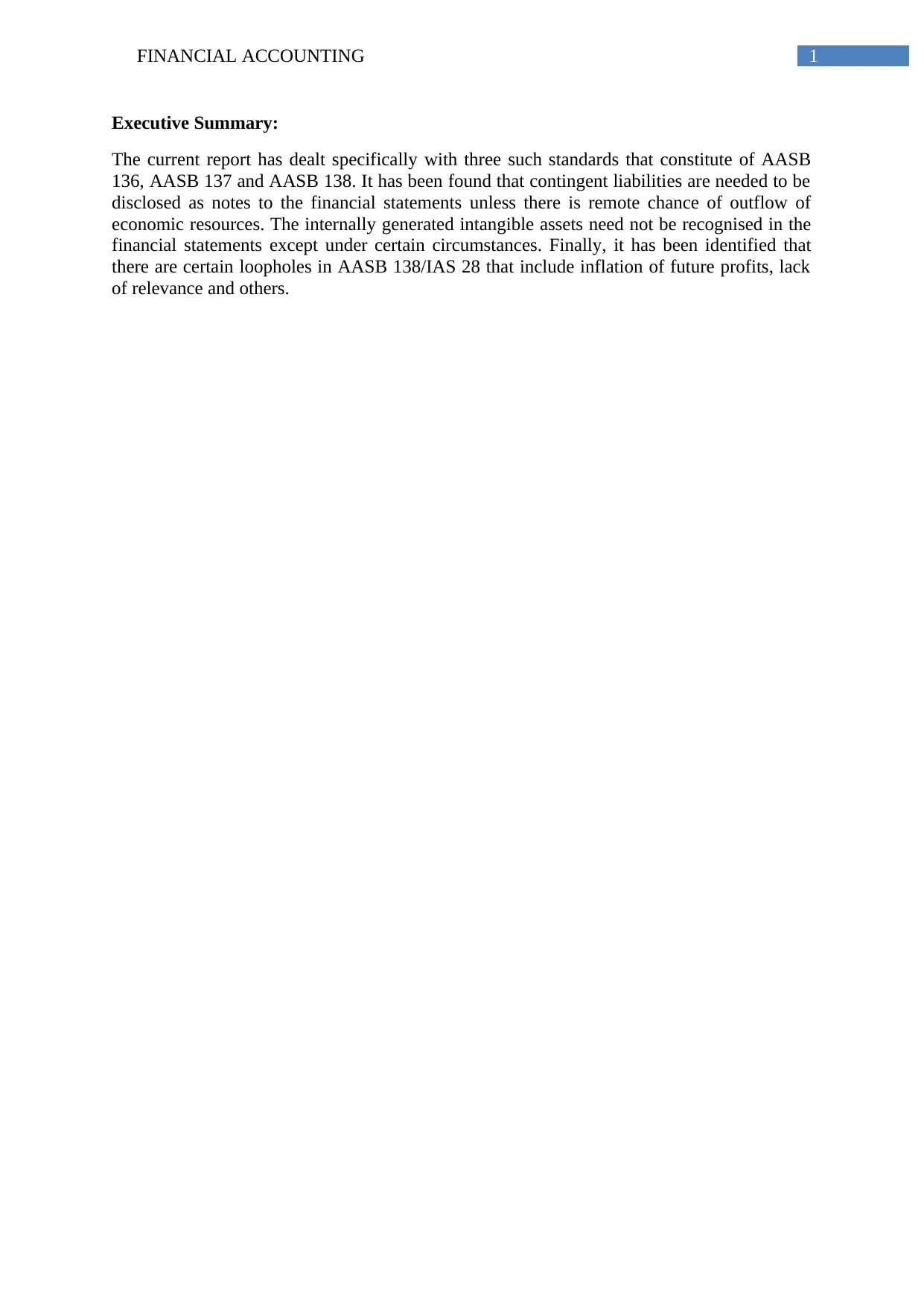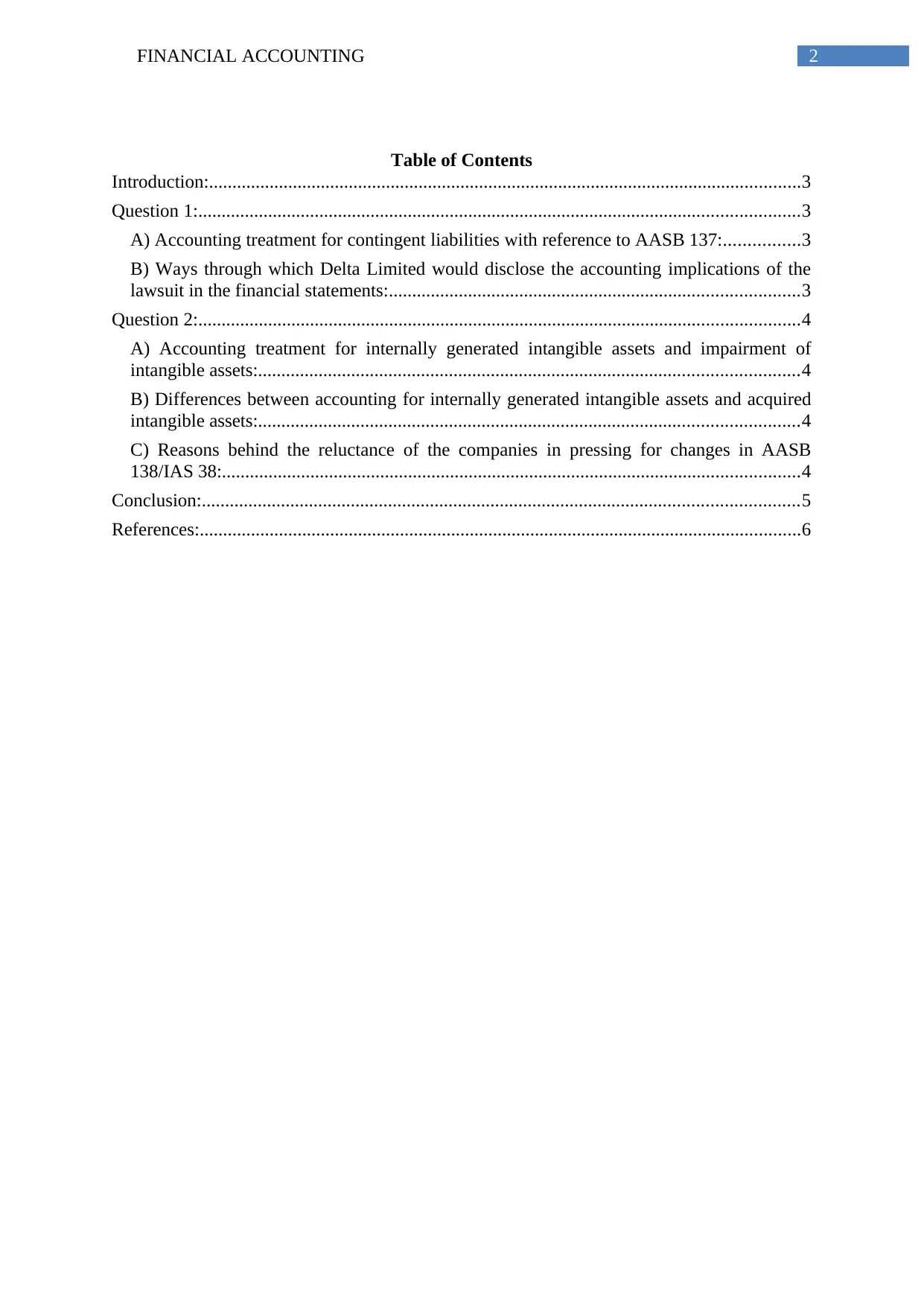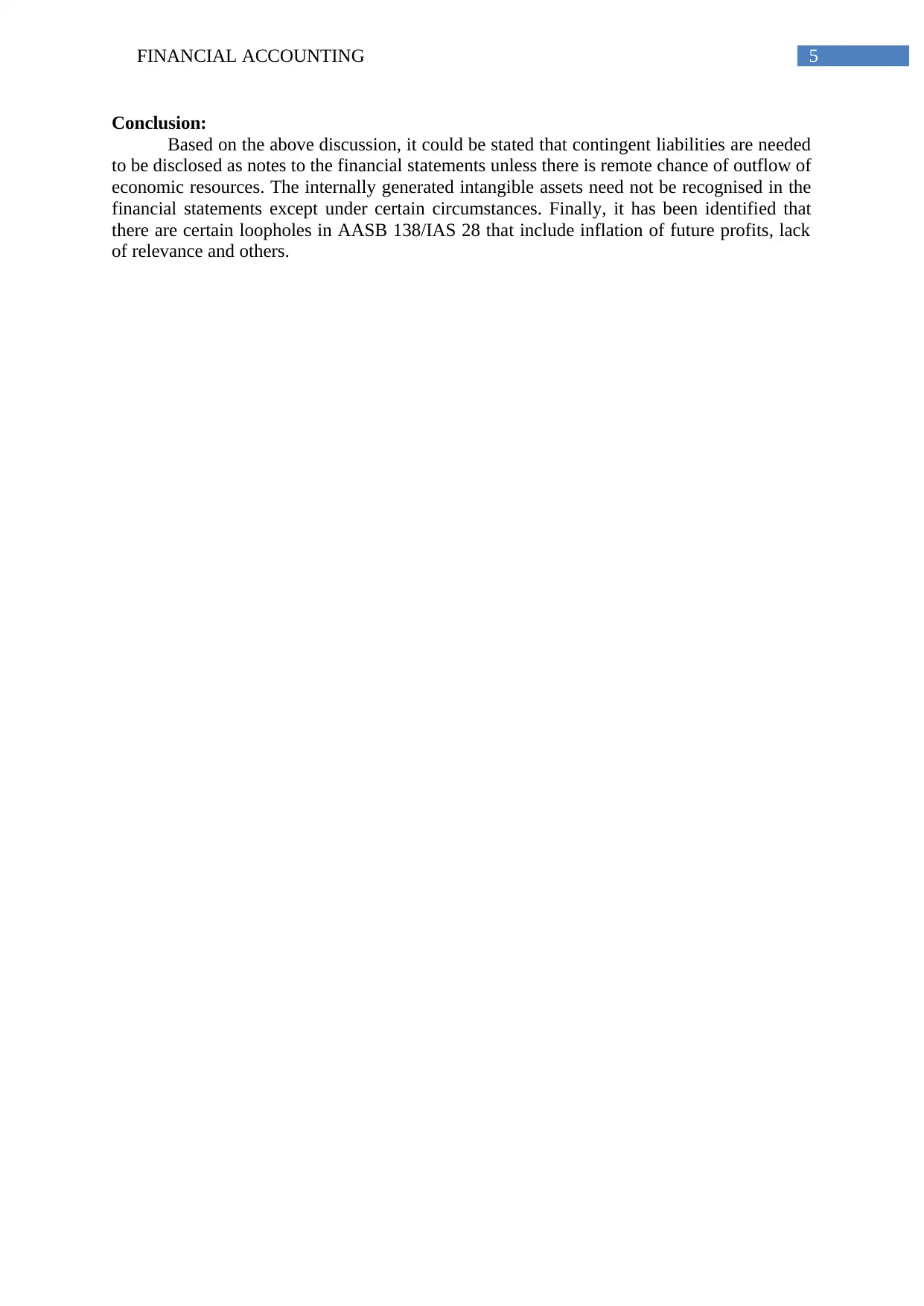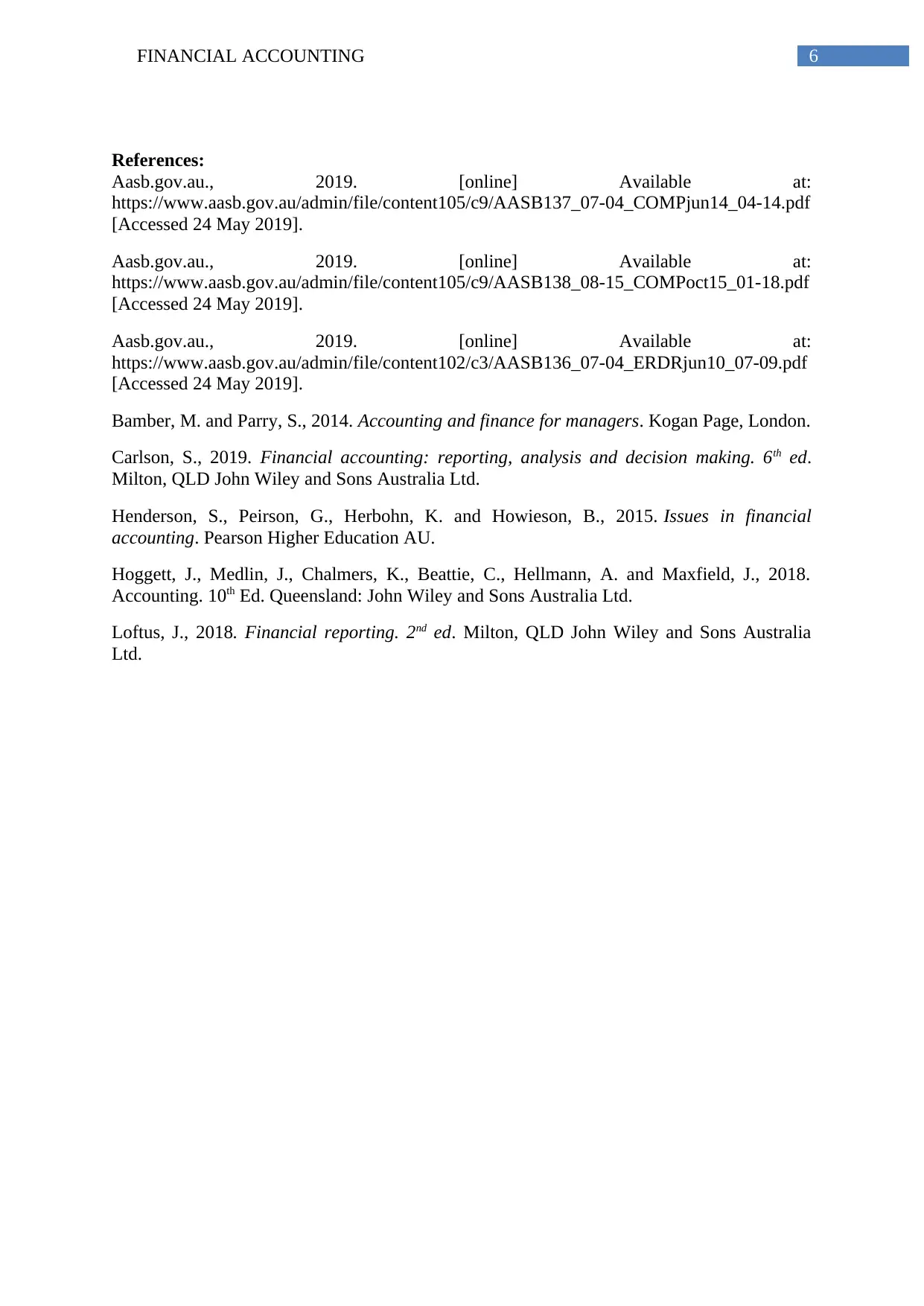Financial Accounting: AASB 136, 137, 138 Standards Report - ACC201
VerifiedAdded on 2022/10/18
|7
|1611
|125
Report
AI Summary
This report provides an in-depth analysis of AASB 136, AASB 137, and AASB 138, focusing on the accounting treatment of contingent liabilities and internally generated intangible assets. It discusses the disclosure requirements for contingent liabilities under AASB 137, particularly in the context of a lawsuit against Delta Limited. The report also examines the accounting treatment and impairment of internally generated intangible assets, highlighting the differences between these and acquired intangible assets. Furthermore, it explores the reasons behind companies' reluctance to push for changes in AASB 138/IAS 38, including the preference for inflated profits and the perceived lack of relevance of capitalized numbers. The report concludes that contingent liabilities must be disclosed unless the outflow of economic resources is remote, and that internally generated intangible assets are not recognized except under specific conditions.

Running head: FINANCIAL ACCOUNTING
Financial Accounting
Name of the Student:
Name of the University:
Author’s Note:
Course ID:
Financial Accounting
Name of the Student:
Name of the University:
Author’s Note:
Course ID:
Paraphrase This Document
Need a fresh take? Get an instant paraphrase of this document with our AI Paraphraser

1FINANCIAL ACCOUNTING
Executive Summary:
The current report has dealt specifically with three such standards that constitute of AASB
136, AASB 137 and AASB 138. It has been found that contingent liabilities are needed to be
disclosed as notes to the financial statements unless there is remote chance of outflow of
economic resources. The internally generated intangible assets need not be recognised in the
financial statements except under certain circumstances. Finally, it has been identified that
there are certain loopholes in AASB 138/IAS 28 that include inflation of future profits, lack
of relevance and others.
Executive Summary:
The current report has dealt specifically with three such standards that constitute of AASB
136, AASB 137 and AASB 138. It has been found that contingent liabilities are needed to be
disclosed as notes to the financial statements unless there is remote chance of outflow of
economic resources. The internally generated intangible assets need not be recognised in the
financial statements except under certain circumstances. Finally, it has been identified that
there are certain loopholes in AASB 138/IAS 28 that include inflation of future profits, lack
of relevance and others.

2FINANCIAL ACCOUNTING
Table of Contents
Introduction:...............................................................................................................................3
Question 1:.................................................................................................................................3
A) Accounting treatment for contingent liabilities with reference to AASB 137:................3
B) Ways through which Delta Limited would disclose the accounting implications of the
lawsuit in the financial statements:........................................................................................3
Question 2:.................................................................................................................................4
A) Accounting treatment for internally generated intangible assets and impairment of
intangible assets:....................................................................................................................4
B) Differences between accounting for internally generated intangible assets and acquired
intangible assets:....................................................................................................................4
C) Reasons behind the reluctance of the companies in pressing for changes in AASB
138/IAS 38:............................................................................................................................4
Conclusion:................................................................................................................................5
References:.................................................................................................................................6
Table of Contents
Introduction:...............................................................................................................................3
Question 1:.................................................................................................................................3
A) Accounting treatment for contingent liabilities with reference to AASB 137:................3
B) Ways through which Delta Limited would disclose the accounting implications of the
lawsuit in the financial statements:........................................................................................3
Question 2:.................................................................................................................................4
A) Accounting treatment for internally generated intangible assets and impairment of
intangible assets:....................................................................................................................4
B) Differences between accounting for internally generated intangible assets and acquired
intangible assets:....................................................................................................................4
C) Reasons behind the reluctance of the companies in pressing for changes in AASB
138/IAS 38:............................................................................................................................4
Conclusion:................................................................................................................................5
References:.................................................................................................................................6
⊘ This is a preview!⊘
Do you want full access?
Subscribe today to unlock all pages.

Trusted by 1+ million students worldwide

3FINANCIAL ACCOUNTING
Introduction:
In order to conduct business operations smoothly, it is necessary for the Australian
organisations to adhere to certain accounting standards for making the accounting treatments
in their financial reports. This report would deal specifically with three such standards that
constitute of AASB 136, AASB 137 and AASB 138. The first section would analyse the
accounting treatment for contingent liabilities in relation to AASB 137 and the accounting
implications for the provided lawsuit in the context of Delta Limited. The second section
would emphasise on the accounting treatment of intangible assets that are generated
internally within the organisation and impairment associated with the same. Moreover,
adequate explanation would be provided regarding the differences between the internally
generated intangible assets and acquired intangible assets. Finally, the report would shed light
on finding out the reasons of the reluctance of the organisations to press for changes in AASB
138/IAS 38.
Question 1:
A) Accounting treatment for contingent liabilities with reference to AASB 137:
Contingent liabilities are considered as off-balance sheet items, which would be
accounted only when there is crystallisation of liability. In accordance with “Paragraph 27 of
AASB 137”, When there is any current or likely obligation that might but likely would not
need any resource outflow, there should not be any recognition of contingent liability.
However, according to “Paragraph 86 of AASB 137”, it is necessary to make disclosures for
the contingent liability (Aasb.gov.au, 2019). On the other hand, when there is any current or
likely obligation, in which there is remote chance of outflow of resources, there is no need to
recognise any provision and no requirement for disclosure, as per the above-stated
paragraphs. Moreover, the occurrence of a contingent liability is evident in extremely rare
case, in which there is any liability that could not be recognised, since reliable measurement
could not be made. On such circumstance, disclosures are required for contingent liability
(Carlson, 2019).
B) Ways through which Delta Limited would disclose the accounting implications of the
lawsuit in the financial statements:
According to the provided information, a customer filed a lawsuit against Delta
Limited in December 2018 against the damages and costs incurred allegedly because of the
failure of an electrical product. Although the organisation has confidence in defending the
case successfully, the lawyers have advised that it would have to incur $500,000; if it is not
successful in defending the case. According to “Paragraph 86 of AASB 137”, the disclosure
of each group of contingent liability is needed unless there is remote possibility of outflow in
settlement, which is not the case in this situation. However, the paragraph needs that the
estimate of any financial effect has to be measured in accordance with “Paragraphs 36-52 of
AASB 137” (Aasb.gov.au, 2019). This implies that the amount is the best anticipation of the
expense needed for settling the obligation, instead of the amount claimed by the customer.
Thus, as Delta Limited has considerable chance of winning the lawsuit, this event should not
be disclosed in the financial statements of the organisation.
Introduction:
In order to conduct business operations smoothly, it is necessary for the Australian
organisations to adhere to certain accounting standards for making the accounting treatments
in their financial reports. This report would deal specifically with three such standards that
constitute of AASB 136, AASB 137 and AASB 138. The first section would analyse the
accounting treatment for contingent liabilities in relation to AASB 137 and the accounting
implications for the provided lawsuit in the context of Delta Limited. The second section
would emphasise on the accounting treatment of intangible assets that are generated
internally within the organisation and impairment associated with the same. Moreover,
adequate explanation would be provided regarding the differences between the internally
generated intangible assets and acquired intangible assets. Finally, the report would shed light
on finding out the reasons of the reluctance of the organisations to press for changes in AASB
138/IAS 38.
Question 1:
A) Accounting treatment for contingent liabilities with reference to AASB 137:
Contingent liabilities are considered as off-balance sheet items, which would be
accounted only when there is crystallisation of liability. In accordance with “Paragraph 27 of
AASB 137”, When there is any current or likely obligation that might but likely would not
need any resource outflow, there should not be any recognition of contingent liability.
However, according to “Paragraph 86 of AASB 137”, it is necessary to make disclosures for
the contingent liability (Aasb.gov.au, 2019). On the other hand, when there is any current or
likely obligation, in which there is remote chance of outflow of resources, there is no need to
recognise any provision and no requirement for disclosure, as per the above-stated
paragraphs. Moreover, the occurrence of a contingent liability is evident in extremely rare
case, in which there is any liability that could not be recognised, since reliable measurement
could not be made. On such circumstance, disclosures are required for contingent liability
(Carlson, 2019).
B) Ways through which Delta Limited would disclose the accounting implications of the
lawsuit in the financial statements:
According to the provided information, a customer filed a lawsuit against Delta
Limited in December 2018 against the damages and costs incurred allegedly because of the
failure of an electrical product. Although the organisation has confidence in defending the
case successfully, the lawyers have advised that it would have to incur $500,000; if it is not
successful in defending the case. According to “Paragraph 86 of AASB 137”, the disclosure
of each group of contingent liability is needed unless there is remote possibility of outflow in
settlement, which is not the case in this situation. However, the paragraph needs that the
estimate of any financial effect has to be measured in accordance with “Paragraphs 36-52 of
AASB 137” (Aasb.gov.au, 2019). This implies that the amount is the best anticipation of the
expense needed for settling the obligation, instead of the amount claimed by the customer.
Thus, as Delta Limited has considerable chance of winning the lawsuit, this event should not
be disclosed in the financial statements of the organisation.
Paraphrase This Document
Need a fresh take? Get an instant paraphrase of this document with our AI Paraphraser

4FINANCIAL ACCOUNTING
Question 2:
A) Accounting treatment for internally generated intangible assets and impairment of
intangible assets:
“Paragraph 24 of AASB 138” states that in the absence of any related expenditure on
the existence of intangible asset generated internally, recognition is not possible
(Aasb.gov.au, 2019). The measurement of intangible assets in the initial stage is made at cost.
Expenditure on the formation of internally generated intangibles might be capitalised based
on the classification of expenditure as either research or development (Bamber and Parry
2014). According to “Paragraph 56 of AASB 138”, research is deemed to be original and
planned examination for gaining new knowledge, while development is deemed to be the
application for research findings, as per “Paragraph 59 of AASB 138”. Furthermore,
“Paragraph 63 of AASB 138” states that it is not essential to realise internally generated
intangibles like brands; however, patents are excluded from this list. Finally, accordance to
“Paragraph 10 (a) of AASB 136”, an internally generated intangible asset needs to be tested
for annual impairment by contrasting the recoverable amount with the carrying amount
(Aasb.gov.au, 2019).
B) Differences between accounting for internally generated intangible assets and
acquired intangible assets:
The acquired intangible assets are easier to be realised compared to internally-
generated intangible assets. In case of acquired intangible assets, market transactions occur
and the acquired assets are measured either at cost or fair value for business combinations
(Henderson, et al., 2015). In case of assets acquired during business combination, there might
be use of fair values compared with having to ascertain a cost. With acquired assets, the
assets restricted in “Paragraph 63 of AASB 138” for realisation in the form of internally
generated intangible assets might be realised. After realisation, the treatment for all intangible
assets is almost identical.
C) Reasons behind the reluctance of the companies in pressing for changes in AASB
138/IAS 38:
The primary reasons that the organisations are reluctant to press for alterations in
AASB 138/IAS 38 for internally generated intangible recognition are discussed as follows:
Preference of managers to report inflated profits:
The future earnings and revenues obtained from these acquisitions would be disclosed
unencumbered by the significant expense item, which is intangible asset amortisation
(Hoggett, et al., 2018). The impact on ratios like return on assets and return on equity are
better in future, if write-offs take place currently rather than future periodic amortisations.
Cost and benefit:
The accounting regulations engage the organisations to incur expenses like those
running for analytical procedures, gauging fair values and paying auditors for reviewing the
measures.
Absence of relevance for capitalised numbers:
In case of knowledge-based assets, it is not possible to measure the actual benefits
generated from intangible assets (Loftus, 2018).
Question 2:
A) Accounting treatment for internally generated intangible assets and impairment of
intangible assets:
“Paragraph 24 of AASB 138” states that in the absence of any related expenditure on
the existence of intangible asset generated internally, recognition is not possible
(Aasb.gov.au, 2019). The measurement of intangible assets in the initial stage is made at cost.
Expenditure on the formation of internally generated intangibles might be capitalised based
on the classification of expenditure as either research or development (Bamber and Parry
2014). According to “Paragraph 56 of AASB 138”, research is deemed to be original and
planned examination for gaining new knowledge, while development is deemed to be the
application for research findings, as per “Paragraph 59 of AASB 138”. Furthermore,
“Paragraph 63 of AASB 138” states that it is not essential to realise internally generated
intangibles like brands; however, patents are excluded from this list. Finally, accordance to
“Paragraph 10 (a) of AASB 136”, an internally generated intangible asset needs to be tested
for annual impairment by contrasting the recoverable amount with the carrying amount
(Aasb.gov.au, 2019).
B) Differences between accounting for internally generated intangible assets and
acquired intangible assets:
The acquired intangible assets are easier to be realised compared to internally-
generated intangible assets. In case of acquired intangible assets, market transactions occur
and the acquired assets are measured either at cost or fair value for business combinations
(Henderson, et al., 2015). In case of assets acquired during business combination, there might
be use of fair values compared with having to ascertain a cost. With acquired assets, the
assets restricted in “Paragraph 63 of AASB 138” for realisation in the form of internally
generated intangible assets might be realised. After realisation, the treatment for all intangible
assets is almost identical.
C) Reasons behind the reluctance of the companies in pressing for changes in AASB
138/IAS 38:
The primary reasons that the organisations are reluctant to press for alterations in
AASB 138/IAS 38 for internally generated intangible recognition are discussed as follows:
Preference of managers to report inflated profits:
The future earnings and revenues obtained from these acquisitions would be disclosed
unencumbered by the significant expense item, which is intangible asset amortisation
(Hoggett, et al., 2018). The impact on ratios like return on assets and return on equity are
better in future, if write-offs take place currently rather than future periodic amortisations.
Cost and benefit:
The accounting regulations engage the organisations to incur expenses like those
running for analytical procedures, gauging fair values and paying auditors for reviewing the
measures.
Absence of relevance for capitalised numbers:
In case of knowledge-based assets, it is not possible to measure the actual benefits
generated from intangible assets (Loftus, 2018).

5FINANCIAL ACCOUNTING
Conclusion:
Based on the above discussion, it could be stated that contingent liabilities are needed
to be disclosed as notes to the financial statements unless there is remote chance of outflow of
economic resources. The internally generated intangible assets need not be recognised in the
financial statements except under certain circumstances. Finally, it has been identified that
there are certain loopholes in AASB 138/IAS 28 that include inflation of future profits, lack
of relevance and others.
Conclusion:
Based on the above discussion, it could be stated that contingent liabilities are needed
to be disclosed as notes to the financial statements unless there is remote chance of outflow of
economic resources. The internally generated intangible assets need not be recognised in the
financial statements except under certain circumstances. Finally, it has been identified that
there are certain loopholes in AASB 138/IAS 28 that include inflation of future profits, lack
of relevance and others.
⊘ This is a preview!⊘
Do you want full access?
Subscribe today to unlock all pages.

Trusted by 1+ million students worldwide

6FINANCIAL ACCOUNTING
References:
Aasb.gov.au., 2019. [online] Available at:
https://www.aasb.gov.au/admin/file/content105/c9/AASB137_07-04_COMPjun14_04-14.pdf
[Accessed 24 May 2019].
Aasb.gov.au., 2019. [online] Available at:
https://www.aasb.gov.au/admin/file/content105/c9/AASB138_08-15_COMPoct15_01-18.pdf
[Accessed 24 May 2019].
Aasb.gov.au., 2019. [online] Available at:
https://www.aasb.gov.au/admin/file/content102/c3/AASB136_07-04_ERDRjun10_07-09.pdf
[Accessed 24 May 2019].
Bamber, M. and Parry, S., 2014. Accounting and finance for managers. Kogan Page, London.
Carlson, S., 2019. Financial accounting: reporting, analysis and decision making. 6th ed.
Milton, QLD John Wiley and Sons Australia Ltd.
Henderson, S., Peirson, G., Herbohn, K. and Howieson, B., 2015. Issues in financial
accounting. Pearson Higher Education AU.
Hoggett, J., Medlin, J., Chalmers, K., Beattie, C., Hellmann, A. and Maxfield, J., 2018.
Accounting. 10th Ed. Queensland: John Wiley and Sons Australia Ltd.
Loftus, J., 2018. Financial reporting. 2nd ed. Milton, QLD John Wiley and Sons Australia
Ltd.
References:
Aasb.gov.au., 2019. [online] Available at:
https://www.aasb.gov.au/admin/file/content105/c9/AASB137_07-04_COMPjun14_04-14.pdf
[Accessed 24 May 2019].
Aasb.gov.au., 2019. [online] Available at:
https://www.aasb.gov.au/admin/file/content105/c9/AASB138_08-15_COMPoct15_01-18.pdf
[Accessed 24 May 2019].
Aasb.gov.au., 2019. [online] Available at:
https://www.aasb.gov.au/admin/file/content102/c3/AASB136_07-04_ERDRjun10_07-09.pdf
[Accessed 24 May 2019].
Bamber, M. and Parry, S., 2014. Accounting and finance for managers. Kogan Page, London.
Carlson, S., 2019. Financial accounting: reporting, analysis and decision making. 6th ed.
Milton, QLD John Wiley and Sons Australia Ltd.
Henderson, S., Peirson, G., Herbohn, K. and Howieson, B., 2015. Issues in financial
accounting. Pearson Higher Education AU.
Hoggett, J., Medlin, J., Chalmers, K., Beattie, C., Hellmann, A. and Maxfield, J., 2018.
Accounting. 10th Ed. Queensland: John Wiley and Sons Australia Ltd.
Loftus, J., 2018. Financial reporting. 2nd ed. Milton, QLD John Wiley and Sons Australia
Ltd.
1 out of 7
Related Documents
Your All-in-One AI-Powered Toolkit for Academic Success.
+13062052269
info@desklib.com
Available 24*7 on WhatsApp / Email
![[object Object]](/_next/static/media/star-bottom.7253800d.svg)
Unlock your academic potential
Copyright © 2020–2025 A2Z Services. All Rights Reserved. Developed and managed by ZUCOL.





